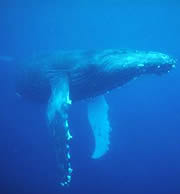|
A deadly alga is the leading suspect in the mass death of humpback whales around 150 miles off Cape Cod, say marine experts.
Carcass sightings suggest that at least 12 whales, mostly humpbacks, have died in the Georges Bank area, making it one of the worst known mass fatalities. "It's really quite disturbing," says whale biologist Phillip Clapham of the Northeast Fisheries Science Center in Woods Hole, Massachusetts.
A red tide of the toxic algae Alexandrium fundyense is the most likely culprit. The algae's poison, saxitoxin, killed 14 whales in the same area in 1987. Saxitoxin can accumulate in mackerel which whales eat.
Unusual currents or weather may have carried the algae to Georges Bank from the coast of Maine and Massachusetts, where they bloom each summer. The algal toxin also poisons people when it gets into mussels and clams.
Investigators are currently analysing the whales' blood, urine and skin for traces of the poison - results are expected later this week. Only one of the dead whales has obvious wounds from fishing tackle or ships.
There is a slim chance that the animals died after acoustic damage caused by navy sonar, says Michael Moore of Woods Hole Oceanographic Institution in Massachusetts, who is involved in the investigation. Until a fresher carcass than the ones already found is towed in and dissected, "we can't rule in or out those events", he says.
Mass whale die-offs - at least those discovered - are rare. But blooms of other harmful algae routinely kill dolphins, sea lions and otters off the southern Californian coast and elsewhere.
Right turn?
The alarm was first raised on 3 July, when researchers found three dead humpbacks in Georges Bay during a routine aerial survey. The normal head-count is one whale every few weeks. "It was enough to make us concerned," says Clapham.
Since we don't know the pathway, we don't know what else to worry about
Don Anderson
Woods Hole Oceanographic Institute
The region's humpback population is thriving and will probably survive the losses. But the deaths raise fears that the endangered Northern Atlantic right whale population - just 320 animals - might also be affected. These mammals feed in the Gulf of Maine during summer.
Right whales might escape acute poison build-ups because they eat plankton rather than fish. "There is no indication they've been affected so far," says Jerry Conway, marine mammal adviser to the Canadian Department of Fisheries and Oceans.
Top
|
